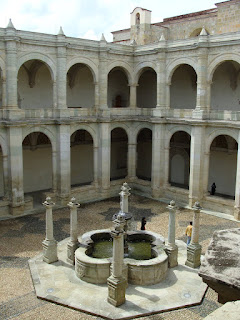My Mexican host sister is a beauty queen. No, really. Within
an hour of moving into my new home here in Oaxaca, my host family had pulled
out recent newspaper clippings displaying Carla, dressed in a white sparkling
ball gown, crowned with a three foot tall tiara standing amidst a crowd of
loyal supporters. Karla isn’t alone in her beauty – her sister has the same
dark eyes, model-esque figure, and long silky hair, and one glance at her
mother makes it clear where both girls get their good looks from.
Beauty in Oaxaca isn’t limited to people. Nested in the
middle of the mountains, Oaxaca offers three hundred and sixty degrees of
breath-taking landscapes. Everywhere you look, the mountains gaze back at you,
making every sunrise spectacular, every gathering of clouds dramatic, and view
a vista. Oaxaca is a city bursting with color – from the long flowing skirts
worn by the street venders working in the busting Zocolo, to the handcrafted tapestries
hanging in the artisan markets, to the patterned dishware used for daily meals.
This city’s beauty extends past what is visible. Beauty is present in the
warmth that seems to radiate between family and community members. It is there
when families stop their work mid-day to return home and eat a home cooked meal
together, and when communities come together for a fiesta that lasts long past
the evening and into the morning hours. And when people from various different communal
groups come together once a year to share and appreciate each other’s
traditions, cultures, and lifestyles, the beauty expressed is unprecedented.
But Oaxaca isn’t all beautiful. The street vendors selling
those brightly colored skirts are clad in tattered clothing that looks like
they’ve never seen a washing machine. The festivals that celebrate indigenous
culture are intensely politicized and can serve to increase tensions between
groups. The clouds that spectacularly form around the mountains in the morning
bring rain by the early afternoon. Oaxaca is a city of contradictions. Families
that hardly seem able to afford their cell phone bill spend inordinate amounts
of money to throw a party. The very rich live next to the very poor. Beauty is
surrounded by the slums.
I spent the better part of my time in Oaxaca trying to reconcile
these contradictions – trying to figure out how so many people who are so poor
can live amongst people who spend outside their means. My last three weeks were
spent researching a domestic servant who both lives with and works for a middle
class family. My research helped me to see that beauty is what you make of it –
poor is all in your definition. This woman who spends her life serving other
people, who doesn’t have a home of her own and moved to the city without money
and without means to support herself, is happy. She is making a living for
herself. She has a family here and she values these relationships more than
houses or money. If you ask this woman, she will tell you that she’s rich.
Now that I’m ready to leave Oaxaca with way more stuffed
into my suitcase than I came here with, I see what beautiful relationships I’ve
gained over the past two months. I may have helped the Mexican economy by
purchasing souvenirs and eating in restaurants, but I’ve gained far more than I
have spent. The mountains in Oaxaca are pretty, the people are warm and
inviting, but the relationship s that form between friends and family show
Oaxaca’s real beauty.














